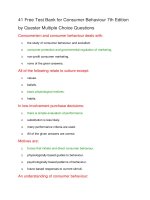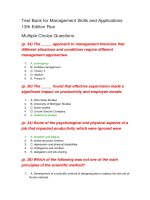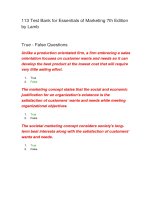Test bank clinical nursing skills techniques 7th perry
Bạn đang xem bản rút gọn của tài liệu. Xem và tải ngay bản đầy đủ của tài liệu tại đây (54.52 KB, 7 trang )
buy this full document at
Perry: Clinical Nursing Skills & Techniques, 7th Edition
Chapter 1: Using Evidence in Nursing Practice
Test Bank
MULTIPLE CHOICE
1. Evidence-based practice is a problem-solving approach to making decisions about patient care
that is grounded in:
a. The latest information found in textbooks
b. Systematically conducted research studies
c. Tradition in clinical practice
d. Quality improvement and risk management data
ANS: B
The best evidence comes from well-designed, systematically conducted research studies found in
scientific journals. Portions of a textbook often become outdated by the time it is published.
Many health care settings do not have a process to help staff adopt new evidence in practice. And
nurses in practice settings lack easy access to risk management data, relying instead on tradition
or convenience.
Some sources of evidence do not originate from research. These include quality improvement
and risk management data; infection control data, retrospective or concurrent chart reviews; and
clinicians’ expertise. Although non–research-based evidence is often very valuable, it is
important that you learn to rely more on research-based evidence.
DIF: Cognitive Level: Comprehension
REF: Text Reference: Page 3
OBJ: Discuss the benefits of evidence-based practice.
TOP: Evidence-Based Practice
KEY: Nursing Process Step: Assessment
2. When evidence-based practice is used, patient care will be:
a. Standardized for all
b. Unhampered by patient culture
c. Variable according to the situation
d. Safe from the hazards of critical thinking
ANS: C
Using your clinical expertise and considering patients’ cultures, values, and preferences ensure
that you will apply both ethically and appropriately the evidence available in practice. Even
when you use the best evidence available, application and outcomes will differ; as a nurse, you
will develop critical thinking skills to determine whether evidence is relevant and appropriate.
DIF: Cognitive Level: Comprehension
REF: Text Reference: Page 3
OBJ: Discuss the benefits of evidence-based practice.
TOP: Evidence-Based Practice
KEY: Nursing Process Step: Assessment
buy this full document at
Full file at />3. When a “PICO” question is developed, the letter that corresponds with the usual standard of care
is:
a.
b.
c.
d.
P
I
C
O
ANS: C
C = Comparison of interest. What is the usual standard of care or current intervention you use
now in practice?
P = Patient population of interest. Identify your patients by age, gender, ethnicity, disease, or
health problem.
I = Intervention of interest. What is the intervention you think is worthwhile to use in practice
(e.g., treatment, diagnostic test, prognostic factor)?
O = Outcome. What result do you wish to achieve or observe as a result of an intervention (e.g.,
change in patient’s behavior, physical finding, change in patient’s perception)?
DIF: Cognitive Level: Knowledge
REF: Text Reference: Page 3
OBJ: Develop a PICO question.
TOP: PICO
KEY: Nursing Process Step: Implementation
4. A well-developed PICO question helps the nurse:
a. Search for evidence
b. Include all four elements of the sequence
c. Find as many articles as possible in a literature search
d. Accept standard clinical routines
ANS: A
The more focused a question you ask is, the easier it is to search for evidence in the scientific
literature.
A well-designed PICO question does not have to include all four elements, nor does it have to
follow the PICO sequence. Do not be satisfied with clinical routines. Always question and use
critical thinking to consider better ways to provide patient care.
DIF: Cognitive Level: Analysis
REF: Text Reference: Page 3
OBJ: Describe the six steps of evidence-based practice.
TOP: Evidence-Based Practice
KEY: Nursing Process Step: Implementation
5. The nurse is not sure that the procedure the patient requires is the best possible for the situation.
Perhaps the quickest way for her to review the research on the topic would be to utilize:
a. CINAHL
b. PubMed
c. MEDLINE
d. The Cochrane Library
ANS: D
Mosby items and derived items © 2010 by Mosby, Inc., an affiliate of Elsevier Inc.
Some material was previously published.
Full file at />The Cochrane Library Database of Systematic Reviews is a valuable source of synthesized
evidence (i.e., preappraised evidence). The Cochrane database includes the full text of regularly
updated systematic reviews and protocols for reviews currently happening. MEDLINE,
CINAHL, and PubMed are among the most comprehensive databases and represent the scientific
knowledge base of health care.
DIF: Cognitive Level: Synthesis
REF: Text Reference: Page 4
OBJ: Describe the six steps of evidence-based practice.
TOP: Evidence-Based Practice
KEY: Nursing Process Step: Implementation
6. The nurse is getting ready to develop a plan of care for a patient who has a specific need. The
best source for developing this plan of care would probably be:
a. The Cochrane Library
b. MEDLINE
c. The NGC
d. CINAHL
ANS: C
The National Guidelines Clearinghouse (NGC) is a database supported by the Agency for
Healthcare Research and Quality (AHRQ). It contains clinical guidelines, systematically
developed statements about a plan of care for a specific set of clinical circumstances involving a
specific patient population. The NGC is a valuable source when you want to develop a plan of
care for a patient. The Cochrane Library Database of Systematic Reviews, MEDLINE, and
CINAHL are all valuable sources of synthesized evidence (i.e., preappraised evidence).
DIF: Cognitive Level: Synthesis
REF: Text Reference: Page 4
OBJ: Describe the six steps of evidence-based practice.
TOP: Evidence-Based Practice
KEY: Nursing Process Step: Implementation
7. The nurse has done a literature search and has found 25 possible articles on the topic that she is
studying. To determine which of those 25 best fit her inquiry, the nurse should first look at:
a. The abstracts
b. Literature reviews
c. The “Methods” sections
d. The narrative sections
ANS: A
The abstract is a brief summary of the article that quickly tells you if the article is research- or
clinically-based. An abstract summarizes the purpose of the study or clinical query, the major
themes or findings, and the implications for nursing practice.
The literature review usually gives you a good idea of how past research led to the researcher’s
question. The “Methods” or “Design” section explains how a research study is organized and
conducted to answer the research question or to test the hypothesis. The narrative of a manuscript
differs according to the type of evidence-based article, either clinical or research.
DIF: Cognitive Level: Application
REF: Text Reference: Page 6
OBJ: Discuss elements to review when critiquing the scientific literature.
TOP: Randomized Controlled Trials
KEY: Nursing Process Step: Implementation
Mosby items and derived items © 2010 by Mosby, Inc., an affiliate of Elsevier Inc.
Some material was previously published.
Full file at />
8. The nurse wants to determine the effects of cardiac rehabilitation program attendance on the
level of postmyocardial depression for individuals who have had a myocardial infarction. The
type of study that would best capture this information would be:
a. A randomized controlled trial
b. A qualitative study
c. A case control study
d. A descriptive study
ANS: B
Qualitative studies examine individuals’ experiences with health problems and the contexts in
which these experiences occur. A qualitative study is best in this case of an individual nurse who
wants to examine the effectiveness of a local program.
Randomized controlled trials involve close monitoring of control groups and treatment groups to
test an intervention against the usual standard of care. Case control studies typically compare one
group of subjects with a certain condition against another group without the condition to look for
associations between the condition and predictor variables. Descriptive studies focus mainly on
describing the concepts under study.
DIF: Cognitive Level: Synthesis
REF: Text Reference: Page 7
OBJ: Discuss ways to apply evidence in practice.
TOP: Randomized Controlled Trials
KEY: Nursing Process Step: Implementation
MULTIPLE RESPONSE
1. To use evidence-based practice appropriately, you need to collect the most relevant and best
evidence and critically appraise the evidence you gather. This process also includes: (Select all
that apply.)
a. Asking a clinical question
b. Applying the evidence
c. Evaluating the practice decision
d. Communicating your results
ANS: A, B, C, D
EBP comprises six steps (Melnyk and Fineout-Overholt, 2005):
1. Ask a clinical question.
2. Collect the most relevant and best evidence.
3. Critically appraise the evidence you gather.
4. Apply or integrate evidence along with one’s clinical expertise and patient preferences and
values in making a practice decision or change.
5. Evaluate the practice decision or change.
6. Communicate your results.
DIF: Cognitive Level: Analysis
REF: Text Reference: Page 3
OBJ: Describe the six steps of evidence-based practice.
TOP: Evidence-Based Practice
KEY: Nursing Process Step: Implementation
Mosby items and derived items © 2010 by Mosby, Inc., an affiliate of Elsevier Inc.
Some material was previously published.
Full file at />2. Evidence-based practice has the ability to:
a. Improve the quality of care provided
b. Improve patient outcomes
c. Improve clinician satisfaction
d. Improve patients’ perceptions
ANS: A, B, C, D
EBP has the potential to improve the quality of care that nurses provide, patient outcomes, and
clinician satisfaction with their practice. Your patients expect nursing professionals to be
informed and to use the safest and most appropriate interventions. Use of evidence enhances
nursing, improving patients’ perceptions of excellent nursing care.
DIF: Cognitive Level: Comprehension
REF: Text Reference: Page 8
OBJ: Discuss the benefits of evidence-based practice.
TOP: Randomized Controlled Trials
KEY: Nursing Process Step: Implementation
COMPLETION
1. _________________is a guide for making accurate, timely, and appropriate clinical decisions.
ANS:
Evidence-based practice
Evidence-based practice is a guide for making accurate, timely, and appropriate clinical
decisions.
DIF: Cognitive Level: Knowledge
OBJ: Define the key terms listed.
KEY: Nursing Process Step: Assessment
REF: Text Reference: Page 2
TOP: Evidence-Based Practice
2. Evidence-based practice requires good ______________.
ANS:
nursing judgment
Evidence-based practice requires good nursing judgment; it is not finding research evidence and
blindly applying it.
DIF: Cognitive Level: Comprehension
REF: Text Reference: Page 3
OBJ: Discuss the benefits of evidence-based practice.
TOP: Evidence-Based Practice
KEY: Nursing Process Step: Assessment
3. While caring for patients, the professional nurse must question ________________.
ANS:
what does not make sense
Always think about your practice when caring for patients. Question what does not make sense
to you, and question what you think needs clarification.
DIF: Cognitive Level: Analysis
REF: Text Reference: Page 3
OBJ: Describe the six steps of evidence-based practice.
TOP: Evidence-Based Practice
Mosby items and derived items © 2010 by Mosby, Inc., an affiliate of Elsevier Inc.
Some material was previously published.
Full file at />KEY: Nursing Process Step: Implementation
4. A systematic review explains if the evidence that you are searching for exists, and whether there
is good cause to change practice. In _____________, all entries include information on
systematic reviews. Individual randomized controlled trials (RCTs) are the gold standard for
research.
ANS:
the Cochrane Library
A systematic review explains if the evidence that you are searching for exists, and whether there
is good cause to change practice. In the Cochrane Library, all entries include information on
systematic reviews. Individual randomized controlled trials (RCTs) are the gold standard for
research.
DIF: Cognitive Level: Analysis
REF: Text Reference: Page 5
OBJ: Describe the six steps of evidence-based practice.
TOP: Evidence-Based Practice
KEY: Nursing Process Step: Implementation
5. __________________ are the gold standard for research.
ANS:
Randomized controlled trials
Individual randomized control trials (RCTs) are the gold standard for research (Titler and others,
2001). An RCT establishes cause and effect and is excellent for testing therapies.
DIF: Cognitive Level: Knowledge
REF: Text Reference: Page 5
OBJ: Explain the levels of evidence in the literature.
TOP: Randomized Controlled Trials
KEY: Nursing Process Step: Implementation
6. The researcher explains how to apply findings in a practice setting for the type of subjects
studied in the _________________ section of a research article.
ANS:
“Clinical Implications”
A research article includes a section that explains if the findings from the study have “Clinical
Implications.” The researcher explains how to apply findings in a practice setting for the types of
subjects studied.
DIF: Cognitive Level: Application
REF: Text Reference: Page 6
OBJ: Discuss elements to review when critiquing the scientific literature.
TOP: Randomized Controlled Trials
KEY: Nursing Process Step: Implementation
7. ____________________ is the extent to which a study’s findings are valid, reliable, and relevant
to your patient population of interest.
ANS:
Scientific rigor
Scientific rigor is the extent to which a study’s findings are valid, reliable, and relevant to your
patient population of interest.
Mosby items and derived items © 2010 by Mosby, Inc., an affiliate of Elsevier Inc.
Some material was previously published.
Full file at />
DIF: Cognitive Level: Application
REF: Text Reference: Page 7
OBJ: Define the key terms listed.
TOP: Randomized Controlled Trials
KEY: Nursing Process Step: Implementation
Mosby items and derived items © 2010 by Mosby, Inc., an affiliate of Elsevier Inc.
Some material was previously published.









